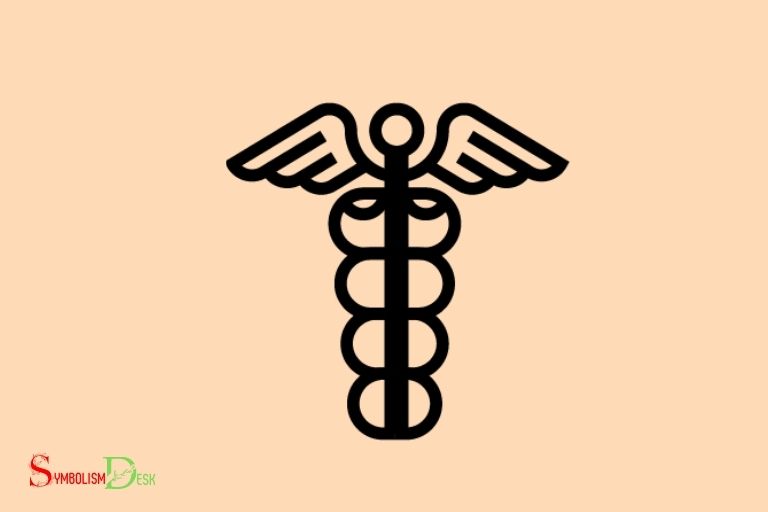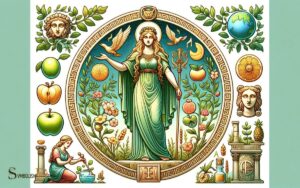What Does Hermes Symbol Mean? Messenger of the Gods!
Hermes’ symbol represents his role as the messenger of the gods, his swiftness, and his ability to travel between the realms of the living and the dead.
The primary symbols associated with Hermes include the caduceus, winged sandals, and the petasos.
Hermes is a Greek god known for his role as a messenger, protector of travelers, and guide to the souls of the dead in the afterlife.
His symbols are a representation of his various attributes and responsibilities, reflecting his divine status and influence in Greek mythology.
The caduceus is perhaps the most well-known symbol associated with Hermes.
This staff, entwined with two serpents and sometimes featuring wings at the top, embodies his role as a mediator and diplomat, helping to negotiate disputes and maintain balance.
Additionally, the caduceus has been connected to medicine and healing, further emphasizing Hermes’ diverse responsibilities.
Similarly, his winged sandals highlight his incredible speed and ability to travel between the realms of the living and the dead, while the **
Interpretation of Hermes Symbol: A Detailed Analysis
| Symbol | Meaning |
|---|---|
| Caduceus (Staff) | Represents commerce, negotiation, and communication. Often mistaken for the Rod of Asclepius, which symbolizes medicine and healing. |
| Wings | Symbolize speed, messenger role, and the ability to travel between realms (divine and mortal) |
| Winged Sandals | Represent swiftness, the ability to travel quickly, and the messenger role |
| Petasos (Winged Hat) | Symbolizes the divine messenger aspect and the ability to move swiftly between the realms |
| Tortoise | Represents Hermes’ inventiveness and resourcefulness, as he is credited with creating the first lyre from a tortoise shell |
| Ram | Symbolizes protection, strength, and leadership; associated with Hermes as the patron of shepherds and protector of livestock |
| Lyre (Musical Instrument) | Represents music, poetry, and arts; Hermes is considered the inventor of the lyre and the god of eloquence |
Key Takeaway

Four Facts About: The Symbolism of Hermes
Introduction: Unraveling The Mystery Of Hermes Symbolism
Hermes is an ancient greek god who had many responsibilities, ranging from being the patron of travelers and merchants to the god of thieves, athletics, and eloquence.
He is known for his extraordinary swiftness, cunning, and versatility. But what does hermes symbol mean?
The symbol is a representation of his fascinating personality, and here are some key points to unravel the mystery of hermes symbolism.
Who Is Hermes?
- Hermes is the son of zeus and maia, one of the seven pleiades, who is the daughter of atlas, known for being a master of magic and transformation.
- The ancient greeks considered hermes to be a guide between the world of the gods and human beings, a messenger who conveyed divine messages to the mortal world.
- Hermes is depicted in artwork wearing a helmet with wings, sandals with wings, and carrying a staff, which was known as a caduceus.
- He is associated with the planet mercury and the day of the week, wednesday.
Significance Of Hermes Symbolism
- The wings on his feet and helmet represent the swift messenger going to and fro with ease, fulfilling his many tasks.
- The caduceus staff is a symbol of peace, a visual representation of the balance between good and evil. It is also tied with healing and medicine.
- The snakes on the caduceus symbolize transformation, rebirth, and death. It is tied deeply to greek mythology about the perfection of the soul, representing the balance between yin and yang or light and dark.
- The symbols of hermes are associated with merchants and business people, denoting trade, traffic, negotiation, and commerce. At the same time, they are also associated with travelers, messengers, and athletes, thus highlighting their versatile nature.
The symbols of hermes are an amalgamation of his various traits and responsibilities. They’re tied to numerous areas of greek society and cultural life, making it a significant symbol in greek mythology. The caduceus, for instance, reflects Hermes’ role as a messenger and mediator, often associated with commerce, negotiation, and communication. His winged sandals and cap highlight his swiftness and ability to traverse realms, connecting the divine and mortal worlds. Unlike Hera’s symbol and its meaning, which often represent themes of marriage and queenship, Hermes’ symbols emphasize versatility and the dynamic nature of his duties.
Hermes Symbolism: Origins And History
Hermes is a greek god, the messenger of gods, and a patron of travelers, thieves, and merchants.
The winged sandals and caduceus (a staff entwined with two serpents) are hermes’s most well-known symbols.
These symbols are intricately woven into the greek mythology and have a fascinating history.
Historical Evolution Of Hermes Symbol
The hermes symbol has evolved over time. Initially, he was depicted as a herdsman, and his symbol was a phallus, which symbolized fertility. However, in the course of time, hermes became an olympian god, and his symbol changed.
The following are the different phases of the evolution of the symbol:
- The phallus: The earliest symbolism of hermes was linked to the phallus. The phallus symbolized fertility and was an actual artifact used in fertility rituals.
- The talaria: The talaria was hermes’s first-ever symbol in greek mythology. They were depicted as a pair of winged sandals that enabled hermes to fly around the world.
- The caduceus: Hermes’s most well-known symbol is the caduceus. It is a staff entwined with two serpents and is often used as a symbol of commerce and negotiation.
Relationship Between Hermes And Greek Mythology
Hermes’s symbols are closely linked to greek mythology, and they play a significant role in the stories.
Here are some of the stories where hermes and his symbols are mentioned:
- The theft of apollo’s cattle: In this story, hermes wears his talaria and flies around the world to steal apollo’s cattle. The talaria helped him fly quickly and easily.
- The slaying of argus: In this story, hermes uses his caduceus to put argus to sleep. The caduceus helped him negotiate and solve problems.
Hermes’s symbols have a fascinating history that’s intricately woven into greek mythology. Understanding the evolution of the symbols and their significance can help us appreciate this greek god’s legacy.
Exploring Hermes Symbolism In Popular Culture
Hermes, the greek god of commerce, thieves, travelers, and athletes, has been an inspiration to many writers, poets, artists, filmmakers, and even fashion designers.
The hermes symbol, the caduceus, has been popular in many different aspects of popular culture.
Hermes Symbolism In Art
Hermes is a popular figure in art history, and the caduceus symbol of hermes has been a popular element in many artworks worldwide.
Here are some of the most notable contributions of hermes symbolism in art:
- Greek mythology depiction: In ancient greece, hermes was commonly depicted with his caduceus, wearing a crown trimmed with wings. He was also portrayed in several forms of art like vase paintings, sculptures, and murals.
- Renaissance art: The caduceus was a popular motif for many renaissance artists, including leonardo da vinci and michelangelo. They incorporated the hermes symbol into their paintings and sculptures, especially in works depicting the medical profession.
Hermes Symbolism In Literature
Hermes, the messenger of the gods, is a popular figure in many literary works across languages and cultures.
Here are some examples of hermes symbolism in literature:
- Greek mythology: Hermes is mentioned in several greek myths, including the story of prometheus, where he played a vital role in freeing him from the eagle’s grip. In the myth of orpheus and eurydice, he guided the musician to the underworld.
- Shakespeare: In shakespeare’s play “the winter’s tale,” we see autolycus, a rogue who refers to himself as a “snapper-up of unconsidered trifles”—a description that reflects hermes’ reputation as a thief.
Hermes Symbolism In Religion
In addition to its proliferation in art and literature, hermes’ symbolism also appears in many religious practices, both ancient and modern.
Here are a few examples:
- Roman mythology: In roman mythology, the god mercury is the equivalent of hermes. The messenger of the gods was worshipped as the god of communication and commerce by roman merchants.
- Hermeticism: The tradition of hermeticism, which grew out of the writing attributed to hermes trismegistus in egypt, is a religious philosophy, and its symbolism draws on many aspects of hermes.
The influence of hermes and his symbol, the caduceus, is evident in various aspects of popular culture. With its rich history and mythology, it may very well continue to be an inspiration for many generations to come.
The Meanings Behind Hermes’ Symbols
Hermes, the greek god of commerce, thieves, travelers, sports, and literature, is known for his symbols, each with its own unique meaning.
From the caduceus to the tortoise, let’s explore the different symbols associated with hermes and their meanings.
Caduceus
The caduceus is a winged staff with two snakes intertwined around it. This symbol has been identified with hermes, the god of trade, eloquence, and messengers.
Some key points to explain this symbol include:
- In mythology, the caduceus was a symbol of hermes’ role as a messenger between the gods and mortals.
- Today, the caduceus is commonly used as a symbol of medicine, even though it has no direct connection to the medical profession.
Winged Sandals
Hermes is often depicted wearing winged sandals, which allow him to fly.
Here are some key points to explain this symbol:
- The wings on hermes’ sandals represent his ability to travel quickly and swiftly, much like a messenger.
- The sandals also represent hermes’ ability to cross boundaries, whether it be between worlds or between different social classes.
- The winged sandals have become a popular symbol of speed and agility, often used in sports logos and branding.
Petasus (Winged Helmet)
The petasus is a winged helmet worn by hermes.
Here are some key points to explain this symbol:
- The wings on the helmet represent hermes’ ability to travel quickly in any direction and cross boundaries between different worlds.
- The helmet is also a symbol of protection and strength, often worn by soldiers in battle.
- The petasus has become a popular symbol of freedom and adventure, often used in outdoor and adventure branding.
Talaria (Winged Sandals)
Talaria, also known as winged sandals, is another representation of hermes’ footwear that has wings attached to it.
Here are some key points to explain this symbol:
- The talaria is often associated with swiftness, allowing hermes to move at great speeds.
- The wings on the sandals represent his ability to fly and traverse any terrain.
- Due to their association with speed and agility, the talaria have become a popular symbol for athletic wear companies.
Tortoise
The tortoise is another significant symbol for hermes.
Here are some key points to explain this symbol:
- In greek mythology, hermes uses a tortoise shell to create the lyre, a musical instrument.
- The tortoise symbolizes creativity, as well as the ability to use available resources to create something new.
- The tortoise also represents perseverance, as it is known for its slow and steady pace.
Hermes’ symbols all hold significant meaning and have become popular among various industries and companies.
From the caduceus to the tortoise, these symbols continue to inspire and represent various aspects of life.
The Significance Of Hermes Symbols In Modern Times
Hyperlinked text should not be used in this response as it cannot be displayed in the ai platform.
Hermes symbols have been a part of human civilization for centuries highlighting the importance of this deity in greek mythology.
In modern times, hermes symbols or signs have taken a new shape, still holding significant value and cultural relevance. Let us explore the profundity of hermes symbols in contemporary times.
Influence Of Hermes Symbolism In Modern Design
The hermes symbol, the caduceus wand, has been heavily incorporated into medical symbols, associated with the messenger of the gods, conveying its importance as a symbol of healing.
The modern meaning of the caduceus is associated with health promotion, showing a connection between the healthcare and the divine.
In contemporary design, hermes symbols, such as the winged sandals and the head of hermes, have been used in branding and merchandise.
You can spot these symbols on high-end designer products such as handbags, shoes, and jewelry, reflecting the popularity of them in modern society. These symbols are often seen as representations of status, luxury, and personal taste, and they hold significant appeal for those who value exclusivity. Interestingly, their designs can sometimes incorporate cultural or religious motifs that carry deeper meanings. For instance, the hand symbol meaning in Islam is often linked to protection, blessings, and faith, adding a layer of spiritual significance to certain pieces.
Beyond the design industry, hermes symbols have influenced modern literature, movies, and media, accentuating the god’s unique and extraordinary traits like agility, quick-witted intelligence, and eloquence.
It is easy to see the importance of hermes remains relevant in today’s contemporary world and has not lost its relevance over time.
Contemporary Interpretation Of Hermes Symbolism
In present times, hermes symbols are not restricted to just be associated with greek mythology, and new meanings can be attached to them, such as specific personality traits or values we admire.
The winged sandals, for instance, can be interpreted as a symbol of being swift, nimble, or free-spirited.
Perhaps the most significant contemporary interpretation of hermes symbolism, however, is the association with communication and the written word.
Hermes was renowned for his ability to craft messages, weaving words together in the most articulate way possible, and remained the patron of writing.
Today, the hermes symbol is used metaphorically to represent the notion of crafting messages and communicating effectively.
This understanding of hermes’ traits has evolved over time and shown that the significance of his symbols has not remained solely in greek mythology; they have become an essential part of many cultures, and their meaning continuously evolves.
Hermes symbols hold significant importance in modern times and represent numerous ideas that continue to hold cultural and emotional relevance.
The symbolism associated with hermes holds special meaning for different people, and its significance stands a testament for its continued relevance in the global society of the present.
What Does the Plug Symbol Mean on Hermes Symbol?
The meaning of the plug symbol on the Hermes symbol can vary. However, if we are referring to the meaning of plug symbol samsung refrigerator, it generally suggests that the appliance is connected to a power source and ready to use. This symbol indicates that the refrigerator is functioning correctly and supplying power to cool and preserve food.
FAQ About What Does Hermes Symbol Mean
What Is The Hermes Symbol?
The hermes symbol is a caduceus, two snakes entwined around a staff, symbolizing commerce and eloquence.
Why Is Hermes Associated With The Caduceus?
Hermes is associated with the caduceus because it represents commerce, good fortune, and eloquence.
What Is The Origin Of The Hermes Symbol?
The hermes symbol dates back to ancient greek mythology when hermes was the messenger of the gods.
What Is The Meaning Of The Hermes Symbol Today?
Today, the hermes symbol is associated with commerce, trade, and communication, and is often used as a symbol for medical professionals.
How Is The Hermes Symbol Used In Modern Times?
The hermes symbol is commonly used as an emblem for businesses in the financial, telecommunications, and medical industries.
Conclusion
Hermes symbol is an intricate one that encompasses a range of meanings and values.
The god of commerce, thieves, and travelers has often been regarded as a symbol of creativity and innovation. He’s also been known to represent speed, skill, and dexterity.
However, what’s fascinating about the symbol is its relevance to modern times. Even in today’s world, the essence of hermes’ symbol has remained significant, and it has inspired countless logos, brands, and designs.
The winged messenger may have ancient roots, but its impact has transcended time and cultures.
Understanding the meaning behind the hermes symbol can help you appreciate the power it holds and gain a new perspective.
So whether you’re an entrepreneur creating a brand or an artist exploring new ideas, remember the story behind the winged messenger and allow its essence to guide you towards success.






